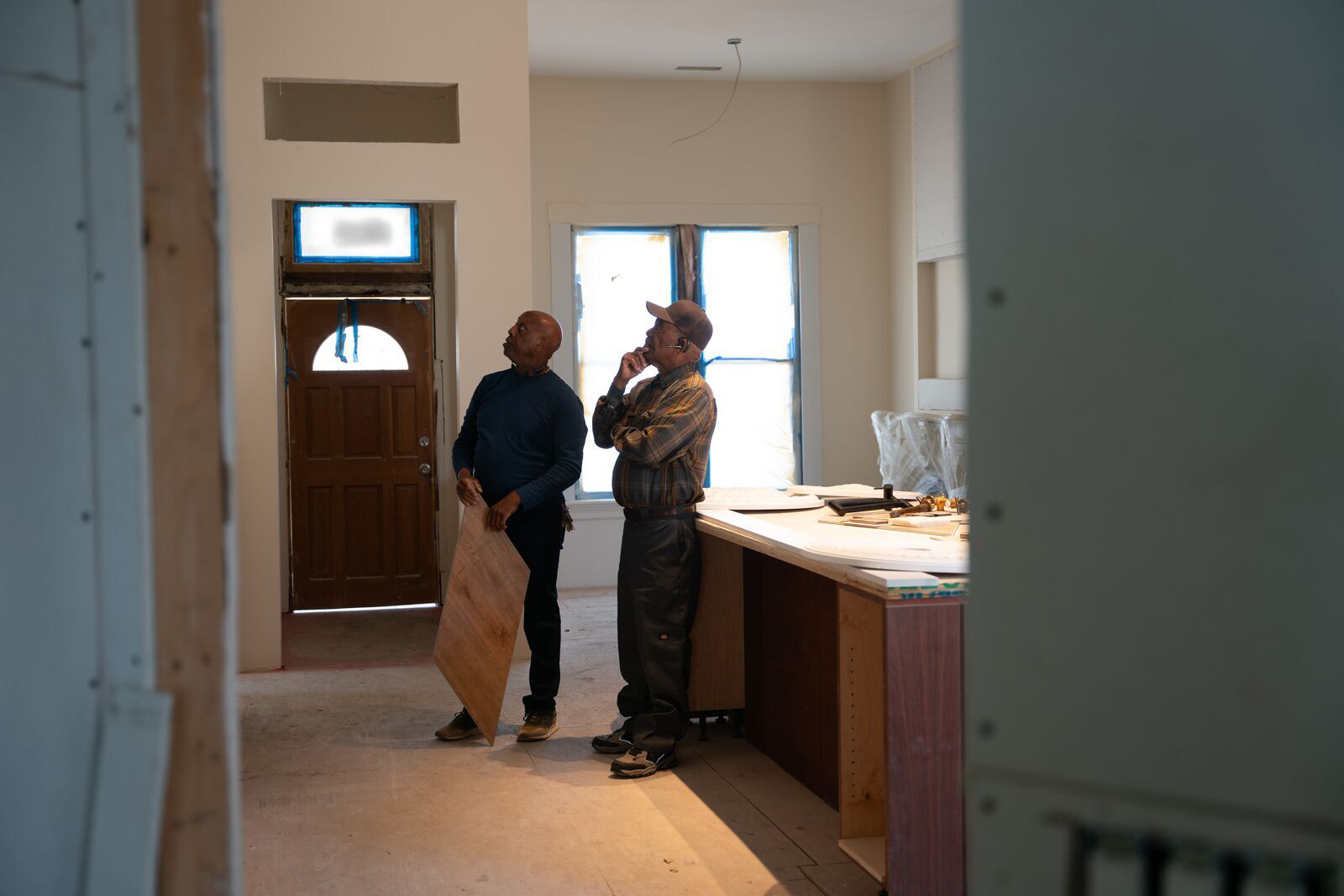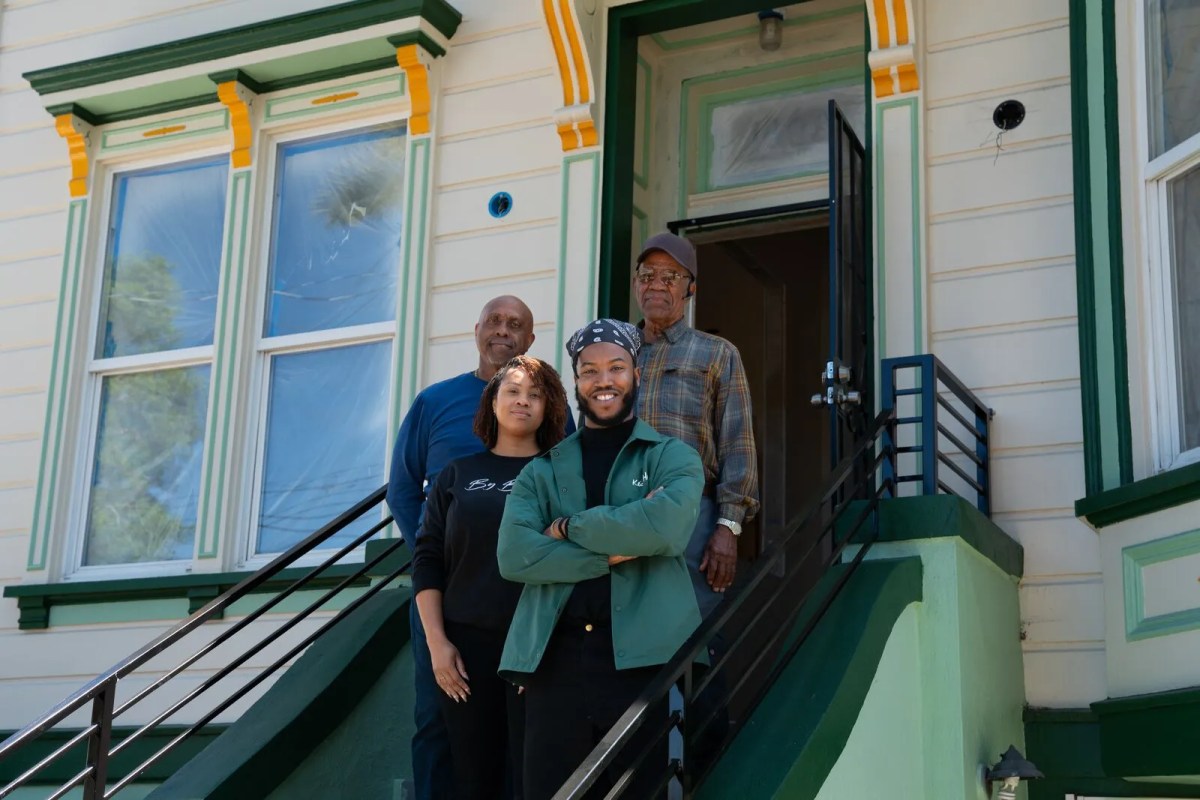This story is part of the Oakland Home Histories series, which explores residential buildings and the people who’ve lived in them. Want us to feature your home? Let us know.
Ron Busby’s family is as West Oakland as they come.
Both sets of grandparents were among the millions of Black Americans who left the South during the Great Migration, in search of opportunity and respect in cities like New York, Philadelphia, Chicago—and Oakland.
Arriving here in the mid-1960s, his maternal grandfather helped construct the West Oakland BART station. Busby’s paternal grandmother taught at Prescott Elementary. His parents met each other in the city.
Busby, 28, was born here too, but he spent most of his adolescence and early adulthood in the Southwest and on the East Coast. Moving back to Oakland in 2018, and buying a house in the Lower Bottoms last summer, has felt like a deeply meaningful homecoming.
“The home and neighborhood reminded me I am rooted in Oakland,” he told The Oaklandside.
But Busby’s not living in his palm-tree-flanked duplex yet. The building, located a few blocks north of 7th Street, needed a lot of work. With the help of his contractor relatives, it’s undergoing a top-to-bottom renovation.
From the outside, it looks close to finished. Busby repainted the house in cream and mint, with gold and forest green accents. It was a conscious decision to avoid the ubiquitous “gentrifier gray” dousing countless houses in Oakland, he said. Inside, it’s still a construction site.
It turns out 2024 is an important year for the property. Built in 1874, just 22 years after Oakland became a city, the building is turning 150.
Busby is cognizant of the fact that the architecture long predates even his family’s three-generation legacy in West Oakland. The house witnessed Oakland’s earliest years, when Prescott’s residents were mostly European immigrants. It stood through World War I, the Roaring Twenties, and the Great Depression. It saw the explosion of a jazz scene along 7th Street and the growth of a Black community during World War II. It watched the killing of Huey Newton and the devastation of the 1989 earthquake. It’s seen the impacts of urban “renewal” and an ongoing housing crisis.
Busby wants to honor the awesome weight of history as he renovates his new digs.
“I really want to find this idea of synthesis between three centuries,” he said. “We’re all stewards of a place, and we’re all borrowing from a future person. These places were beautiful—they’re still beautiful—and we’re passing that on.”
German developer built 300 houses

Busby’s house was built by a German developer named John Ziegenbein. The former produce merchant built almost 300 similar houses in what was then called the “Oakland Point District.” Ziegenbein himself lived in a house he built on Peralta Street.
“He set up a real estate business,” said architect William Coburn, who’s done many renovations of historical homes in the area. “They were built to order, more or less, depending on the individual owner’s needs.”
Some of the old houses around there don’t have foundations, Coburn said, because the original owners didn’t have the money for it.
About 20 years ago, Coburn began painting wooden signs that named, in careful lettering, the original owner and the year of construction for several homes in the neighborhood. Busby’s came with one of these. It notes that the inhabitants were Philip Fuchs, a blacksmith, and Hugh Williams. Oakland Point’s earliest residents after the city’s founding were German, and they gave way to Italians several decades later.
Coburn told The Oakandside he was inspired by similar sign programs in the Massachusetts towns where he grew up. “I see it as a matter of pride for people to understand how old houses are, and that they were associated with many generations of a community,” he said. “They just acknowledge that there’s something special here.”
The homes that Ziegenbein designed, like Busby’s, were all Italianate houses, with variations of hipped roofs, porches, bay windows, and porticos. Some 100 were still standing as of the 1990s, according to the city’s Cultural Heritage Survey. Busby’s two-story house started with just one, added onto sometime in the mid-1900s.

Former residents of Busby’s home led colorful and tragic lives, according to old Oakland Tribune reports. There was the woman whose “notorious” husband Martin Thielman had her falsely locked up in an insane asylum until he was sent to San Quentin for “swindling.” The house was among several shared properties she claimed in the divorce in 1892. Two years later, a “little fellow” no older than 4 who lived there was killed when a streetcar ran him over while he was playing outside. The article’s description of his death is too gruesome to repeat.
In 1889, a resident taught Shakespeare reading and recitation classes out of the home. A few years later the newspaper saw fit to cover a “very pleasant party” held at the house, where a Miss Hilda Ongerth and her friends danced until midnight.
In the 1930s, it was home to a butcher named Herman Pasquini. In the 1940s a couple who lived there posted an ad looking for their lost wartime rations book.
Building BART and bulldozing Victorians

By the time Shelvery Chambers arrived in the Prescott area in 1965, “this whole community was all Black,” he said.
Many who arrived during the early years of the Great Migration got jobs as porters on trains or in the West Oakland railyards. Later, wartime jobs in the shipyards attracted thousands more Black residents.
Chambers, Busby’s grandfather, came from a farm in Oklahoma. He thought Oakland was beautiful. Friends would give each other a hand building and repairing houses, “which made it possible to own homes,” he said. Chambers got a job as a cement foreman.
His construction resume reads like an Oakland history bingo card. His first job was building I-580. Followed by work on the Tube between Oakland and Alameda. Then a freeway in San Jose. Later the West Oakland BART station on 7th Street.
It was a good gig. “At that time, the union wage was higher than any job in an office or bank,” Chambers said. Eventually, he started his own contracting business, Chambers General Construction. To this day, he works on homes in West Oakland and beyond.
While Busby finishes his house, he’s renting an apartment in a building his grandfather constructed.

Many of the infrastructure projects that offered stability for the workers hired to build them also caused upheaval and change. Twelve square blocks of mostly Black homes and businesses were razed in order to build the 7th Street post office in the 1960s. Hundreds of residents were displaced.
The common nickname for Busby’s neighborhood, the Lower Bottoms, first referred to the area west of the Cypress Street Viaduct. The two-story freeway cut through West Oakland in 1957. The same structure later collapsed in the 1989 Loma Prieta earthquake.
Want your house or apartment featured next? Let us know more by filling out this quick form.
When I-980 began its long construction saga amid protests in the 1960s, it sliced Oakland. West Oakland was completely separated from the rest of the city, and thousands more were displaced. Retired Oakland History Center Director Dorothy Lazard moved to 13th Street during this construction as a teenager.
“The miles-long scar in the landscape stretched as far north as the eye could see,” she wrote in her memoir, What You Don’t Know Will Make a Whole New World. If a Victorian house wasn’t demolished it was put up for sale for $1. The catch? You had to move it.

Urban “renewal” projects coupled with the loss of wartime jobs thrust many Lower Bottoms residents into poverty and desperation. At the same time, crime was increasing and city leaders asked OPD to more aggressively patrol West Oakland. Residents of Busby’s house at the time might reflect that. In 1953, an occupant was sentenced to 10 years in prison for carrying a “marijuana cigaret and a paper of heroin in a wallet.” The next year, a resident was arrested in a crackdown on “unemployment insurance chiselers.”
These days, there are active efforts to restore and revive the heyday of the Lower Bottoms. A coalition called 7th Street Thrives aims to “rejuvenate” the corridor, with affordable housing, jobs, and a modern-day version of the old “Harlem of the West.” Preservationists are pushing for the restoration of the 16th Street train station. One of Busby’s neighbors has turned her house into an art piece and mini museum about the Black Panther Party.
Busby is optimistic about the neighborhood where he’s settling.
“Buying a home is inherently an act of hope,” he said. “To me, there’s a lot to get excited about with West Oakland and Oakland in general. The doom and gloom you see all the time in the headlines is not feeling like my lived reality.”
Houses like his, he said, “are testaments to the survival of a city, the resilience of a city.”
The family business

On an afternoon in early April, Busby, his uncle, and his grandfather were buzzing about the house, peering at fixtures, measuring door frames, consulting in low voices.
When Busby says he wants his renovation to honor history, he’s not speaking abstractly.
On what will be the kitchen island lay ornate ceiling medallions. Wrapped in plastic to the side was an 1884 fireplace fixture Busby sourced from Columbus, Ohio. He’s planning to install old-school parquet flooring too.
“They tell me to stay on budget,” Busby said, gesturing to his elders. “I say, stay authentic.”
There are modern features too, he points out. The duplex will be all-electric.
Uncle Paul Chambers, Shelvery’s son, said he was “born into” the family construction business. So was his sister. His daughter Passion Chambers, who swung by that afternoon, is learning the ropes.
Busby does something different, working as head of product for a national nonprofit that supports Black businesses. But he credits his family with his eye for design and attention to detail. He’s hands-on with the project, hanging drywall with the rest of them and documenting his progress on Instagram.
Even with all the change in the neighborhood, the family is still well-known, getting nearly all of its construction business from word of mouth.
Paul said they’ve hung onto the lessons of the Oklahoma farm all this time. “Plant a seed,” and make sure you and yours have the essentials—food, water, shelter.
“Ronald’s able to benefit from the harvest.”
Busby is quite literally planning to plant in his home’s yard—native trees, of course. But he’s been convinced to keep the palms too.

